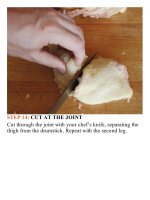The food lab better home cooking through science ( PDFDrive ) 431
Bạn đang xem bản rút gọn của tài liệu. Xem và tải ngay bản đầy đủ của tài liệu tại đây (242.46 KB, 2 trang )
PAN-SEAREDCHICKENPARTS
There’saterribleproblemsweepingthiscountry,an
insidiousonethathasmanagedtoworkitswayinto
nearlyeveryhousehold,withnodistinctionsamongrace,
gender,orclass.
I’mtalkingaboutdrychickenbreasts,andit’stimeforusto
Just Say No. Luckily, there’s an easy program to help you
doit,andallitrequiresisasmallinvestment:agoodinstantreadthermometer.
As with many problems in life, the root causes of dry
chicken are noble, and they stem from the government’s—
more specifically, the Food and Drug Administration’s—
recommendationtocookchickenbreaststo165°F.Justlike
beefandpork,chickenmeattightensasyoucookit,andby
the time it’s reached 165°F, it’s irretrievably, irrevocably
dry. With chicken legs, this is not so much of a problem.
Becauseoftheirlargeamountsoffatandconnectivetissue,
you can cook a chicken leg all the way to 180°F or even
190°Fandstillgetsomesemblanceofsucculence.Chicken
breasts, though, with their large, roundish shape and total
lack of fat, can’t handle temperatures much above 145°F
(foradiscussiononchickensafety,seehere).
So,what’sthebestwaytocookachicken?Ifwelearned
anything from pan-searing steaks and pork chops, it would
seemtobetoflipthechickenrepeatedlyasitcooks.Well,I
trieditandquicklylearnedthat,achickenisnotacow,and
therearekeydifferencesbetweenthestructureofachicken
breastandthatofasteakthatmakeflip-cookingunfeasible
—namely, the skin. Luckily for us, the skin provides some
amazingbenefitsthatallowustocookchickenmuchmore
easilythanwecancookbeefandpork.Now,now,Iknow
some odd folks don’t like eating chicken skin (surely its
most delicious feature!), but I’m here to tell you that
regardless of whether you end up eating it or pushing it to
the side of your plate, it shouldstay on the chicken while
youcookit.
Here’s the thing: without skin, what happens when you
try to pan-sear a chicken breast? The meat at the exterior
dries out, turning stringy andleathery, and not at all
pleasant.Tryusingthemultiple-flipmethodwithaboneless,
skinless chicken breast, and you’ll end up leaving half the
chicken on the bottom of the pan as you flip it.There are
fewthingsinlifeIhatemorethanskinless,bonelesschicken









